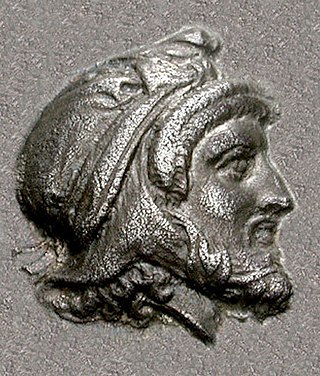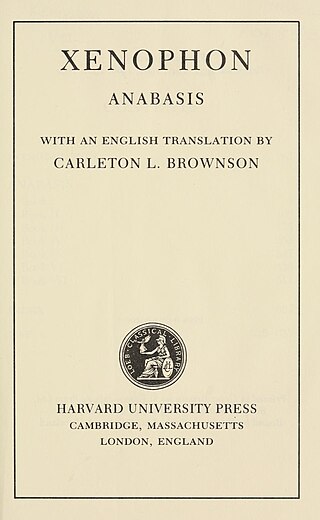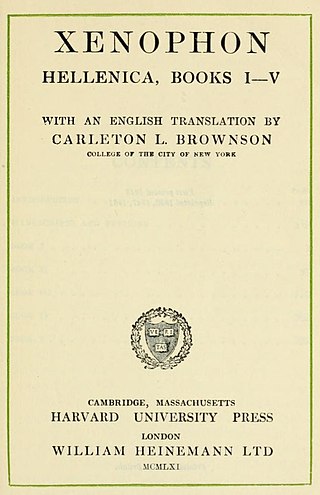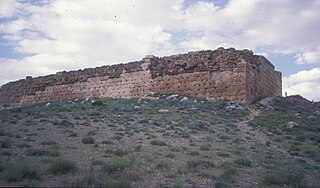
Xenophon of Athens was a Greek military leader, philosopher, and historian. At the age of 30, he was elected as one of the leaders of the retreating Greek mercenaries, the Ten Thousand, who had been part of Cyrus's attempt to seize control of the Achaemenid Empire. As the military historian Theodore Ayrault Dodge wrote, "the centuries since have devised nothing to surpass the genius of this warrior". Xenophon established precedents for many logistical operations and was among the first to describe strategic flanking maneuvers and feints in combat.

Cyrus the Younger was an Achaemenid prince and general. He ruled as satrap of Lydia and Ionia from 408 to 401 BC. Son of Darius II and Parysatis, he died in 401 BC in battle during a failed attempt to oust his elder brother, Artaxerxes II, from the Persian throne.

The Battle of Cunaxa was fought in the late summer of 401 BC between the Persian king Artaxerxes II and his brother Cyrus the Younger for control of the Achaemenid throne. The great battle of the revolt of Cyrus took place 70 km north of Babylon, at Cunaxa, on the left bank of the Euphrates. The main source is Xenophon, a Greek soldier who participated in the fighting.

Pharnabazus II was a Persian soldier and statesman, and Satrap of Hellespontine Phrygia. He was the son of Pharnaces II of Phrygia and grandson of Pharnabazus I, and great-grandson of Artabazus I. He and his male ancestors, forming the Pharnacid dynasty, had governed the satrapy of Hellespontine Phrygia from its headquarters at Dascylium since 478 BC. He married Apama, daughter of Artaxerxes II of Persia, and their son Artabazus also became a satrap of Phrygia. According to some accounts, his granddaughter Barsine may have become Alexander the Great's concubine.

Anabasis is the most famous work of the Ancient Greek professional soldier and writer Xenophon. It gives an account of the expedition of the Ten Thousand, an army of Greek mercenaries hired by Cyrus the Younger to help him seize the throne of Persia from his brother, Artaxerxes II, in 401 BC.

The Ten Thousand were a force of mercenary units, mainly Greeks, employed by Cyrus the Younger to attempt to wrest the throne of the Persian Empire from his brother, Artaxerxes II. Their march to the Battle of Cunaxa and back to Greece was recorded by Xenophon, one of their leaders, in his work Anabasis.

Hellenica simply means writings on Greek (Hellenic) subjects. Several histories of 4th-century Greece, written in the mould of Thucydides or straying from it, have borne the conventional Latin title Hellenica. The surviving Hellenica is an important work of the Ancient Greek writer Xenophon and one of the principal sources for the last seven years of the Peloponnesian War not covered by Thucydides, as well as the war's aftermath.
Thapsacus was an ancient town along the western bank of the Euphrates river that would now lie in modern Syria. Thapsacus was the Greek and Roman name for the town. The town was important and prosperous due to its river crossing, which allowed east-west land traffic to pass through it. Its precise location is unknown and there are several different locations identified as the site of Thapsacus. One possibility is a location close to Carchemish, which now lies in Turkey, on its border with Syria. Karkamış and Jarabulus are the closest modern towns in Turkey and Syria respectively. More recently it has been suggested that Thapsacus was renamed to Seleucia at the Zeugma, which lies further upstream on the Euphrates.

Media is a region of north-western Iran, best known for having been the political and cultural base of the Medes. During the Achaemenid period, it comprised present-day Iranian Azerbaijan, Iranian Kurdistan and western Tabaristan. As a satrapy under Achaemenid rule, it would eventually encompass a wider region, stretching to southern Dagestan in the north. However, after the wars of Alexander the Great, the northern parts were separated due to the Partition of Babylon and became known as Atropatene, while the remaining region became known as Lesser Media.

Athura, also called Assyria, was a geographical area within the Achaemenid Empire in Upper Mesopotamia from 539 to 330 BC as a military protectorate state. Although sometimes regarded as a satrapy, Achaemenid royal inscriptions list it as a dahyu, a concept generally interpreted as meaning either a group of people or both a country and its people, without any administrative implication.

The Medo-Persian conflict was a military campaign led by the Median king Astyages against Persis in the mid 6th-century BCE. Classical sources claim that Persis had been a vassal of the Median kingdom that revolted against Median rule, but this is not confirmed by contemporary evidence. After some battles the Persians led by Cyrus the Great emerged victorious, subsequently conquering Median territories and establishing the Achaemenid Empire.

Calpe, also Kalpas or Calpas, was a port city of ancient Bithynia in Asia Minor, on the shore of the Black Sea. It was located not far from the mouth of the river Calpas. It was mentioned in Xenophon's Anabasis. Xenophon, who passed through the place on his retreat with the Ten Thousand, describes it as about halfway between Byzantium and Heraclea Pontica on a promontory, part which projects into the sea is an abrupt precipice. The neck which connects the promontory with the mainland is only 400 feet (120 m) wide. The port is under the rock to the west, and has a beach; and close to the sea there is a source of fresh water. The place is minutely described by Xenophon. The place is mentioned also by Pliny the Elder, Solinus, Arrian, who places it 210 stadia from the mouth of the Psilis, and Stephanus of Byzantium.

The fall of Babylon was the decisive event that marked the total defeat of the Neo-Babylonian Empire to the Achaemenid Empire in 539 BC.
Meno, son of Alexidemus, was an ancient Thessalian political figure, probably from Pharsalus.
Ariaeus was a Persian general who fought alongside Cyrus the Younger at the Battle of Cunaxa and later was involved in the assassination of Tissaphernes.
Arexion was a seer. He served under Xenophon with the Ten Thousand in the Persian Expedition recorded by Xenophon in his work, Anabasis. He was the presiding soothsayer during this expedition after Silanos from Ambracia deserted the army. As a soothsayer he practiced extispicy, the observance of animal entrails to foresee future events. He is also referred to as Arexion the Arcadian which indicates he was a native of Arcadia, a region in the center of the Peloponnese.
Tim Rood is a British classical scholar, specialising in Greek historiography and reception studies. He is Professor of Greek Literature at the University of Oxford and a fellow and tutor at St Hugh's College, Oxford. His research is principally concerned with the literary techniques of Herodotus, Thucydides, and Xenophon.

Cheirisophus was a Spartan general who fought with the Ten Thousand under Cyrus the Younger. Cheirisophus was sent by the Spartan ephors with 700 heavily armed men to aid Cyrus the Younger in his expedition against his brother Artaxerxes in 401 BC. He joined Cyrus on his march at Issus in Cilicia. After the Battle of Cunaxa, Clearchus sent Cheirisophus with a delegation to the Persian general Ariaeus to make an offer of placing him on the Persian throne, an offer which Ariaeus declined.
Teuthrania was a town in the western part of ancient Mysia, and the name of its district about the river Caicus, which was believed to be derived from a legendary Mysian king Teuthras. This king is said to have adopted, as his son and successor, Telephus, a son of Heracles; and Eurypylus, the son of Telephus, appears in the Odyssey as the ruler of the Ceteii. The town was situated between Elaea, Pitane, and Atarneus. The nearby towns of Halisarna, Pergamum, and Teuthrania had been given by the Persian king Darius I to the Spartan king Demaratus about the year 486 BCE for his help in the expedition against Greece. Demaratus's descendants continued to rule these cities at the beginning of the 4th century BCE. During the withdrawal of Pergamum from The March of the Ten Thousand, it was attacked by, among others, troops from Halisarna and Teuthrania under command of Procles, son of Demaratus. In the Hellenica, Xenophon relates that Teuthrania, together with Pergamum, Halisarna, Gambrium, Palaegambrium, Myrina and Gryneium were delivered by their rulers to the army that, under the command of the Spartan Thimbron, around the year 399 BCE, had come to the area to try to liberate the Greek colonies from the Persian domain.
Halisarna was a town of ancient Mysia on the north bank of the river Caïcus. The nearby towns of Halisarna, Pergamum, and Teuthrania had been given by the Persian king Darius I to the Spartan king Demaratus about the year 486 BCE for his help in the expedition against Greece. Demaratus's descendants continued to rule these cities at the beginning of the 4th century BCE. During the withdrawal of Pergamum from The March of the Ten Thousand, it was attacked by, among others, troops from Halisarna and Teuthrania under command of Procles, son of Demaratus. In the Hellenica, Xenophon relates that Halisarna, together with Pergamum, Teuthrania, Gambrium, Palaegambrium, Myrina and Gryneium were delivered by their rulers to the army that, under the command of the Spartan Thimbron, around the year 399 BCE, had come to the area to try to liberate the Greek colonies from the Persian domain.











